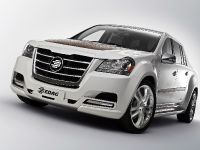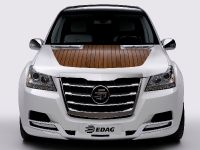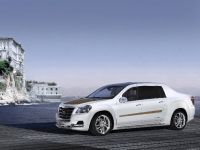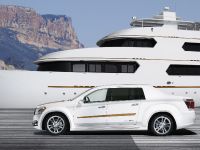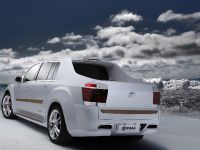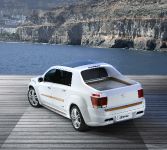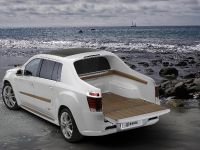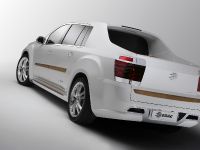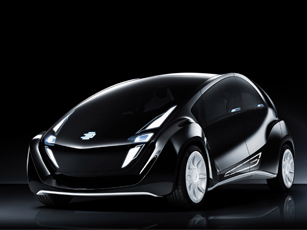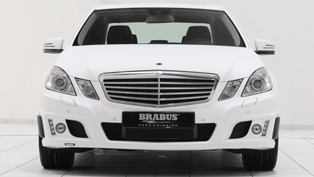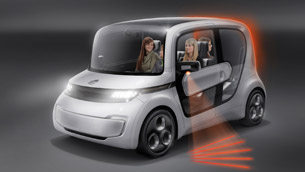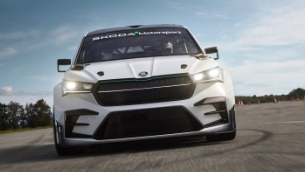Edag Luv
The new concept car from EDAG Engineering + Design AG will be making its first appearance on March 6, 2007, in Geneva – the "EDAG LUV". The design concept of the "LUV" is based on an luxury-class SUV and incorporates a maritime look from bow to stern: oiled teakwood on the hood, as the flooring on the interior, and on the elegant cargo area conveys a maritime flair. But the "EDAG LUV" is a real eye-catcher in other respects as well: the cargo area, behind the two rows of seats with plenty of room for 5 passengers, has been outfitted with teakwood and distinctly resembles a quarterdeck – in keeping with the maritime look of the concept car.
The Module Concept of the "EDAG LUV" – An Economical Approach to Vehicle Derivatives
But the maritime design of the "EDAG LUV" is just the covering for a modular concept which makes it possible to turn vehicles into derivatives or niche vehicles at reasonable expenditures of time and money.
In coming up with their shell concept, the EDAG team of engineers, headed by project manager Andreas Funk, set themselves the goal of using the greatest possible number of carry-over parts.
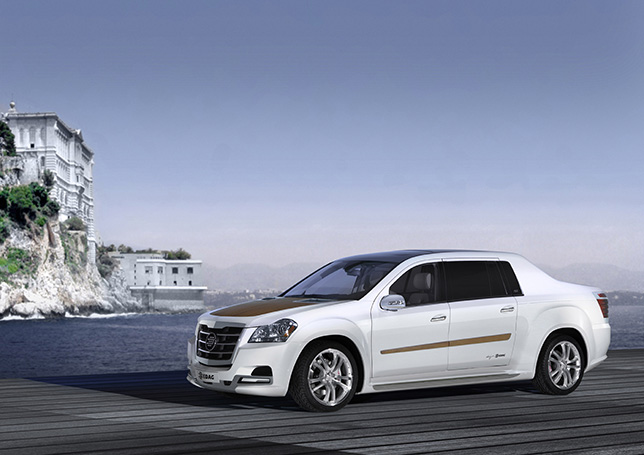 Edag Luv
Edag Luv
The group can certainly be proud of the results of the intelligent module concept: 90% of the parts required to perform the metamorphosis of a luxury-class SUV into the "EDAG LUV" come off the parts shelf of the basic vehicle. For example, the extension of the floor pan by 512 mm was realized using original parts. The wheelhouses were also used without any modifications, as were the parts for the rear-end finish, which includes integration of the standard power-lift system from the sedan.
"In addition to our efforts to use a maximum number of identical parts, we were especially careful to keep the existing production concept of the basic vehicle in mind during the development of the "EDAG LUV"," explains Andreas Funk. "The self-supporting body can be completely welded using standard tongs. It goes without saying that we used simulation models during the development of the entire body concept to test crash behavior and rigidity so that we could guarantee the highest level of quality and safety."
The advantages of the EDAG module concept are obvious. Thanks to the use of identical parts and taking into account the production concept, a vehicle concept which is visually completely new can be realized under economically interesting conditions.
"More and more end customers are asking for niche vehicles, and this type of design turns the production of such cars into a "business case" for the manufacturers," points out Johannes Barckmann, Head of Design at EDAG, in describing the concept.
The "EDAG LUV" – A New Vehicle Segment
"LUV", the name of the concept car, is not only a term used by sailors (it is German for "luff", the windward side of a vessel), but also defines a new vehicle segment – the luxury utility vehicle.
"In taking the maritime world as a leitmotif for the design of the "EDAG LUV", we deliberately selected a niche theme. We wanted to demonstrate in exemplary fashion that it is possible to create a distinctive vehicle class and not only to give a vehicle a new look. And to do that with as little technical effort as possible," is how Johannes Barckmann explains the intentions behind the design concept. So the cargo area of the "EDAG LUV" is elegantly tied in with the passenger cell by the harmonious lines of the body design. The utility vehicle character so often evident in pick-up models is no longer discernible in the "EDAG LUV". On the contrary, the "EDAG LUV" radiates elegance and autonomy and cannot be classified by any of the vehicle segments existing today.
Yet the luxury image which has been created is only one example for the idea of a versatile vehicle concept. Speaking of versatile: the pick-up module can be exchanged for a convertible or coupe module simply by releasing a catch mechanism integrated into the body of the "EDAG LUV". A clever move by the EDAG developers so that additional derivative variants can be realized flexibly and at low cost.
Innovation in the Interior - The PC Takes Its Place in the Vehicle The "EDAG LUV" has innovative solutions on the inside as well. The EDAG development team has integrated two UMPCs (UltraMobile PCs) into the headrests, bringing the PC world into the vehicle. The user can use a specially developed mechanism to insert the fully operational PCs easily into the headrests. Passengers in the rear seat can use their Office applications such as PowerPoint, Excel, and Word in the vehicle, plus WLAN and UMTS provide them with Internet access, enabling them to download and answer their e-mails during the trip. Furthermore, integrated Webcams even make it possible to hold Net meetings during the trip. Users can also access their music or DVD collection from the car. The trick: The UMPCs are connected to the vehicle"s audio system so that the MP3 files or videos stored on the computer can also be used in the vehicle. The integration of the computer keyboards into the interior of the "EDAG LUV" has also been handled elegantly: modern form-fitting foil keyboards have been embedded in the folding tables available for use by rear-seat passengers. Background lighting makes it possible to work even while traveling at night and is yet another futuristic design element in the interior.
"The integration of so-called consumer devices into the vehicle architecture is a highly interesting topic for the manufacturers. This can result in a genuine additional value for the end customers by making the functionality of the PC world usable in the vehicle as well," notes Dr. Robert Hentschel, Director of EDAG Electrics/Electronics.
"Being a full-range developer of vehicles and an integrator in the field of electrics/electronics, we are determined to develop solutions in this area which are stylish, geometrically and functionally high-quality, and practical."
EDAG is currently pursuing two solution approaches: 1. A second integration stage will tie the UMPCs into the vehicle architecture for luxury-class vehicles. The advantage: the driver can use operating elements – e.g., on the steering wheel – to access directly the functions or data of the UMPC. 2. The EDAG developers are planning the UMPC as an after-market product for compact and midsize cars. The aim here is to develop concepts for various models produced by car-makers so that the devices can be integrated ergonomically and geometrically into the interior without a jarring visual effect. What makes this especially enticing is the possibility of utilizing the UMPC as an on-board computer and high-quality display device by connecting it to the vehicle architecture, providing yet another service, as well as making the complete functionality of a PC available in the car.
With this as a goal, EDAG is working closely with the Intel Corporation on the development of solutions for the electrical and electronic connection as well as on the integration of "nomadic devices" in the vehicle interior. EDAG will rely on the latest in Intel technology, processors, and chip sets. Especially small dimensions for the chips and low energy consumption are only some of the criteria for their use in cars.
The Company is planning to present the "EDAG LUV" at the upcoming IAA in Frankfurt in the second integration stage, i.e., with access to the UMPCs via operating elements of the car.
Innovative Development Competence by EDAG EDAG will be presenting the "EDAG LUV" in Geneva as proof of its competence, underscoring the capabilities of the world"s largest independent development partner to develop economically sound innovative vehicle concepts optimized for production. The project has been realized in only three months, from definition of the concept and design process to the development to the ready-to-roll prototypes, and is on the verge of being realized as a Premium Edition.
BRABUS is one of the partners in this project. The tuner from Bottrop contributed not only the 462 hp / 340 kW high-performance BRABUS 6.1 displacement engine for the EDAG LUV that allows this all-wheel-drive vehicle to accelerate to 100 km/h in a little more than six seconds for a speed of 250 km/h.
BRABUS also provides the classy 10Jx22 monoblock S wheels fitted with 295/35 ZR 22 YOKOHAMA tires, the air suspension module as well as the high-performance brake system from its product line-up. The 12-piston aluminum fixed calipers and ventilated, perforated 380 x 36 millimeter front brake disks and the 6-piston fixed calipers and 355 x 28 mm rear brake disks reach a braking performance typically achieved only by genuine sports cars.
Exclusive all-leather appointments and attractive interior accessories are an additional BRABUS specialty. The BRABUS saddlery combined the finest white leather with black seams and cords for a superior interior finish of the EDAG LUV that leaves nothing to be desired.
Source: Edag
